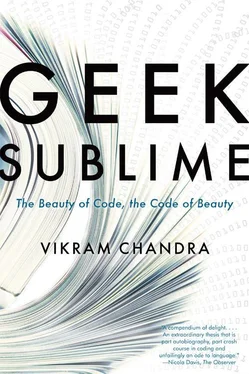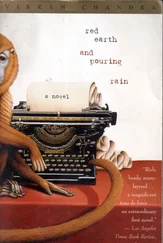
brainfuck is a “Turing tarpit,” which is to say it is a very small language in which you can write any program that you could write in C or Java; but attempting to do so would, well, fuck your brain, and therefore the delectable frisson of terror the code above induces in discerning code cognoscenti. brainfuck is venerable and famous, but my favorite esoteric language is Malbolge, which was designed solely to be the most outrageously difficult language to program in. It is named, appropriately, after the eighth circle of hell in Dante’s Inferno , Malebolge (“Evil ditches,” reserved for frauds). In the language Malbolge, the result of any instruction depends on where it is located in memory, which effectively means that what specific code does changes with every run. Code and data are very hard to reuse, and the constructs to control program flow are almost nonexistent. 11Malbolge inverts the sacred commandments of literate programming, and is so impenetrable that it took two years after the language was first released for the first working program to appear, and that program was not written by a human, but generated by a computerized search program that examined the space of all possible Malbolge programs and winnowed out one possibility. “Hello, world!” in Malbolge is:

And yet, this snippet doesn’t convey the true, titillating evil of Malbolge, which changes and quakes like quicksand. To contemplate Malbolge is to stare into the abyss in which machines speak their own tongues, indifferent to the human gaze; the programmer thereafter knows the pathos of her situation, and recognizes the costs of sacrilege. The coder’s quest is for functionality—“all computer programs are designed to accomplish some kind of task”—and the extension and maintenance of that functionality demands clarity and legibility. Illegibility, incomprehensibility — that way madness lies.

The desire for lucidity as well as power, and therefore the maximization of productivity and happiness among programmers, has — according to some accounts — created more than eight thousand computer languages over the last half-century. 12Each of these artificial, formal languages embodies a philosophy of human-computer interaction; whole family trees of dialects have evolved from the hacker’s eternal desire to improve, to implement better. Adherents of one language will criticize another’s choice with the fierce religiosity of those who are convinced that they are completely rational. The computer scientist Edsger Dijkstra, for instance, didn’t hold back his feelings in a famous 1975 memo: FORTRAN was an “infantile disorder”; PL/I was a “fatal disease”; programmers exposed to BASIC were “mentally mutilated beyond hope of recognition”; use of COBOL “cripples the mind, its teaching should, therefore, be regarded as a criminal offence”; APL was a “mistake, carried through to perfection.” 13
In any given year, there are a couple of languages that are cool — at the time of this writing, all the really hip kids are learning Clojure. And there are certain languages that smell of terminal uncoolness: users of Microsoft’s Visual Basic are regarded by many as the dorks of the computing world, the most Mort-ish of the Morts. Like all its predecessors in the long “Basic” lineage of languages, which goes back to 1964, Visual Basic has an English-like syntax. With its first release in 1991, Visual Basic provided a relatively easy way for non-experts to build programs for Windows; precisely for these reasons, it has attracted the contempt of the math-inclined Einsteins, who despise its verbosity and blame its accessibility for the plague of terrible programs that still afflicts Windows.
The evolution of computer languages also reflects the development of computer science and the craft of programming. Procedural programming called for the decomposition of complexity into simpler procedures which were then called sequentially. But this method was clearly inadequate: Big Balls of Mud were being built everywhere, software projects overshot budgets and failed at an alarming rate, there was an ever-present air of crisis. In the mid-eighties, a newly popular method, “Object Oriented Programming,” offered salvation. OOP — first conceived in the nineteen sixties — uses “objects,” code constructions that contain both data (attributes that describe the object) and behavior (methods or procedures that you can call to effect changes); objects interact by passing messages to each other. In procedural programming, information and functionality were scattered all over the place; a doctor’s addresses might be in a database, the knowledge of how to use these addresses in a procedure somewhere, and the ability to create new addresses in yet another procedure elsewhere. With OOP, the promise was that you could neatly encapsulate both data and behavior inside objects, and then use these objects to faithfully model the stuff of the real world, which of course is full of objects. Using OOP, you could write code like this to create an object representing a new doctor and store his phone number:
Doctor drKumar = new Doctor();
drKumar.PhoneNumber = ‘5105550568’;
Here, “drKumar” is an object of the type “Doctor”; one of the data fields of this object is “PhoneNumber.” You may have another type called “Patient,” which might have a data field called “Diagnosis.” So with objects, when you needed the good Dr. Kumar’s address, you didn’t have to go searching through a master list of addresses. You could just retrieve the drKumar object and write something like the following to assign Dr. Kumar’s address to the “MailingAddress” field of the report the user wanted to print:
report.MailingAddress = drKumar.Address;
The dawn of OOP was a heady time. I imagined shiny metallic objects rising out of the primal Big Ball of Mud, pristine and clean, shooting messages at each other like bolts of energy. The rest of the programming world seemed equally excited: hundreds of books were written, OOP conferences were held, some programmers became superstar OOP gurus who charged large sums to teach the secrets of the OOP way of thinking. Every prominent programming language now acquired object orientation, if only as a possible method among others. And really, programming in this new idiom made it possible to solve certain problems with ease and a degree of elegance.
Yet — Big Balls of Mud continued to be born, to grow. Software projects continued to crash and burn, ruining budgets and careers. If OOP managed to avoid the inevitable snarls of procedural programming, it introduced new kinds of complexity. Even small systems now divided functionality into hundreds and thousands of objects. Thinking about all these pieces and layers and their interactions became increasingly difficult; subtle bugs arose from what felt like spooky action at a distance — entanglements between objects emerged from their whirling dance. In defense, programmers codified best practices into a smorgasbord of easily abbreviated rubrics: Separation of Concerns, Single Responsibility Principle, Don’t Repeat Yourself, Liskov Substitution Principle. Automated testing of each independent section of code became more crucial than ever, first to ensure that the code was actually doing what you wanted, and later to be sure that it was still doing what you wanted after you made changes in some other section of code — effects sometimes flowed unpredictably from one region to another.
Читать дальше















